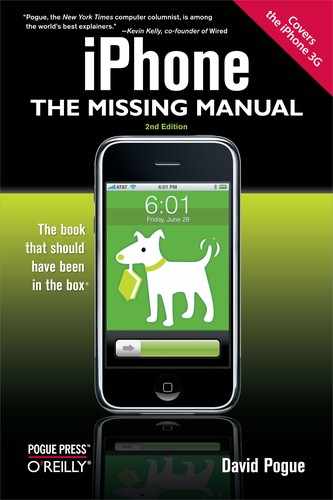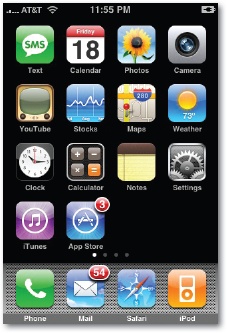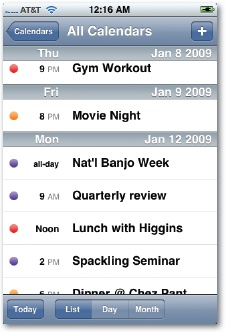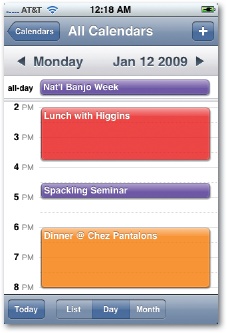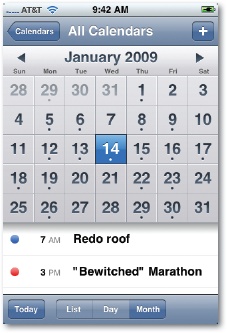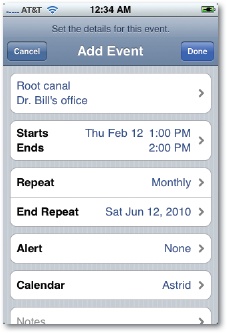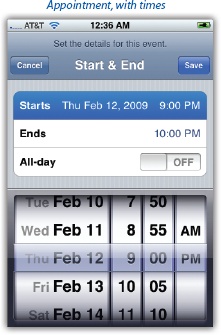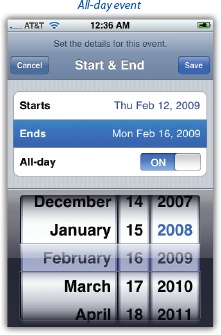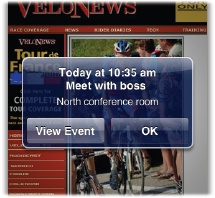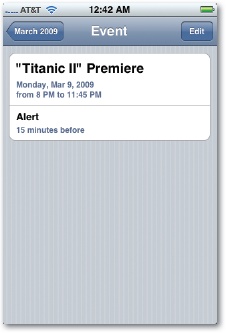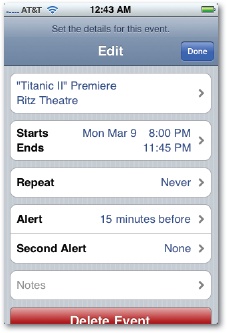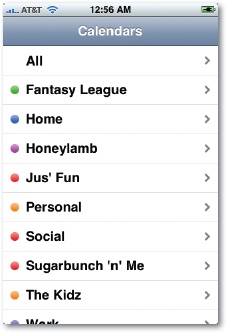Your Home screen comes loaded with the icons of 18 applications. These are the essentials, the starting points; eventually, of course, you'll fill that Home screen, and many overflow screens, with additional programs that you download and install yourself (Chapter 11).
The starter programs include major gateways to the Internet (Safari), critical communications tools (Phone, Text, and Mail), visual records of your life (Photos, Camera), Apple shopping centers (iTunes, App Store), and a well-stocked entertainment center (iPod).
Most of those programs get chapters of their own. This chapter covers the smaller programs: Calendar, YouTube, Stocks, Maps, Weather, Clock, Calculator, and Notes.
What kind of digital companion would the iPhone be if it didn't have a calendar program? In fact, not only does it have a calendar—it even has one that syncs with your computer.
If you maintain your life's schedule on a Mac (in iCal or Entourage) or a PC (in Outlook), then you already have your calendar on your iPhone. Make a change in one place, and it changes in the other, every time you sync over the USB cable.
Better yet, if you have a MobileMe account or work for a company with an Exchange server (Chapters Chapter 14 and Chapter 15), your calendar can be synchronized with your computer automatically, wirelessly, over the air. (And if you have both MobileMe and Exchange, some real fun awaits; see Exchange + MobileMe.)
Or you can use Calendar all by itself.
Tip
The Calendar icon on the Home screen shows what looks like one of those paper Page-a-Day calendar pads. But if you look closely, you'll see a sweet touch: It actually shows today's day and date!
By clicking one of the View buttons at the bottom of the screen, you can switch among these views:
List view offers you a tidy chronological list of everything you've got going on, from today forward. Flick or drag your finger to scroll through it.
Day shows the appointments for a single day in the main calendar area, broken down by time slot. Tap the ◄ and ► buttons to move backward or forward a day at a time.
Month shows the entire month. Little dots on the date squares show you when you're busy. Tap a date square to read, in the bottom part of the screen, what you've got going on that day. (You can flick or drag that list to scroll it.)
In all three views, you can tap Today (bottom left) to return to today's date.
The basic calendar is easy to figure out. After all, with the exception of one unfortunate Gregorian incident, we've been using calendars successfully for centuries.
Even so, recording an event on this calendar is quite a bit more flexible than entering one on, say, one of those "Hunks of the Midwest Police" paper calendars.
Start by tapping the ![]() button (top-right corner of the screen). The Add Event screen pops up, filled with tappable lines of information. Tap one (like Title/Location, Starts/Ends, or Repeat) to open a configuration screen for that element.
button (top-right corner of the screen). The Add Event screen pops up, filled with tappable lines of information. Tap one (like Title/Location, Starts/Ends, or Repeat) to open a configuration screen for that element.
For example:
Title/Location. Name your appointment here. For example, you might type Fly to Phoenix.
The second line, called Location, makes a lot of sense. If you think about it, almost everyone needs to record where a meeting is to take place. You might type a reminder for yourself like My place, a specific address like 212 East 23, a contact phone number, or a flight number.
Use the keyboard (Double-Tap) as usual. When you're finished, tap Save.
Starts/Ends. On this screen, tap Starts, and then indicate the starting time for this appointment, using the four spinning dials on the bottom half of the screen. The first sets the date; the second, the hour; the third, the minutes; the fourth, AM or PM. If only real alarm clocks were this much fun!
Then tap Ends, and repeat the process to schedule the ending time. (The iPhone helpfully pre-sets the Ends time to one hour later.)
An All-day event, of course, means something that has no specific time of day associated with it: a holiday, a birthday, a book deadline. When you turn this option On, the Starts and Ends times disappear. Back on the calendar, the appointment jumps to the top of the list for that day.
Tip
Calendar can handle multiday appointments, too, like trips away. Turn on All-day—and then use the Starts and Ends controls to specify beginning and ending dates. On the iPhone, you'll see it as a list item that repeats on every day's square. Back on your computer, you'll see it as a banner stretching across the Month view.
Tap Save when you're done.
Repeat. The screen here contains common options for recurring events: every day, every week, and so on. It starts out saying None.
Once you've tapped a selection, you return to the Edit screen. Now you can tap the End Repeat button to specify when this event should stop repeating. If you leave the setting at Repeat Forever, you're stuck seeing this event repeating on your calendar until the end of time (a good choice for recording, say, your anniversary, especially if your spouse might be consulting the same calendar).
In other situations, you may prefer to spin the three dials (month, day, year) to specify an ending date, which is a useful option for car and mortgage payments.
Alert. This screen tells Calendar how to notify you when a certain appointment is about to begin. Calendar can send any of four kinds of flags to get your attention. Tap how much notice you want: 5, 15, or 30 minutes before the big moment; an hour or two before; a day or two before; or on the day of the event.
When you tap Save and return to the main Add Event screen, you'll see that a new line, called Second Alert, has sprouted up beneath the first Alert line. This line lets you schedule a second warning for your appointment, which can occur either before or after the first one. Think of it as a backup alarm for events of extra urgency. Tap Save.
Once you've scheduled these alerts, at the appointed time(s), you'll see a message appear on the screen. (Even if the phone was asleep, it appears briefly.) You'll also hear a chirpy alarm sound.
Notes. Here's your chance to customize your calendar event. You can type any text you want in the notes area—driving directions, contact phone numbers, a call history, or whatever. Tap Save when you're finished.
When you've completed filling in all these blanks, tap Done. Your newly scheduled event now shows up on the calendar.
Note
If you use iCal on the Macintosh, you might notice that the iPhone offers no way to place each new appointment into a calendar— that is, a color-coded category like Home or Social.
When you set up the iPhone for syncing, though, you can specify which iCal category all of the iPhone's newly created events fall into. See Phone.
To examine the details of an appointment in the calendar, tap it once. The Event screen appears, filled with the details you previously established.
To edit any of these characteristics, tap Edit. You return to what looks like a clone of the New Event screen shown on Making an Appointment.
Here, you can change the name, time, alarm, repeat schedule, or any other detail of the event, just the way you set them up to begin with.
The one difference: This time, there's a big red Delete Event button at the bottom. That's the only way to erase an appointment from your calendar.
Tip
The Calendar program doesn't have a to-do list, as you may have noticed. It may someday, as Apple adds new software features via free updates.
In the meantime, you can always fire up Safari and head over to www.tadalist.com, a free, iPhone-friendly, online To Do-list program.
A calendar, in Apple's somewhat confusing terminology, is a color-coded subset—a category—into which you can place various appointments. They can be anything you like. One person might have calendars called Home, Work, and TV Reminders. Another might have Me, Spouse 'n' Me, and The Kidz. A small business could have categories called Deductible Travel, R&D, and R&R.
You can't create calendar categories, or change their colors, on the iPhone—only in your desktop calendar program. Or, if you're a MobileMe member (Chapter 14), you can also set up your categories at www.me.com; all of your categories and color codings show up on the iPhone automatically.
What you can do is choose whether you want to view just one category—or all categories at once.
All you have to do is tap Calendars at the top of any Calendar view. You arrive at the big color-coded list of your categories.
This screen exists partly as a reference, a cheat sheet to help you remember what color goes with which category, and partly as a tappable subset-chooser. That is, if you tap the Work category, you return to the calendar view you were just viewing, but now all categories are hidden except the one you tapped.
